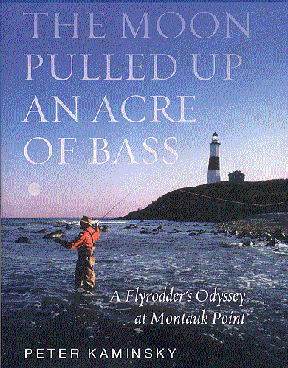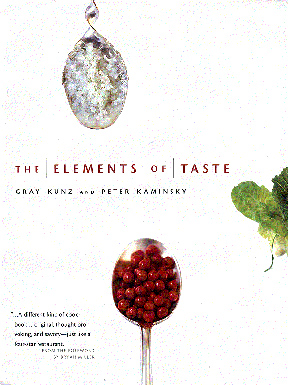|
Web
Exclusives:Features December
19, 2001: By J.I. Merritt '66 "I didn't grow up fishing," says Kaminsky, a writer and TV producer. "I was working at National Lampoon at the time — an insane and crazy and hyper place. I had to get away and went on vacation to the Florida Keys, where I saw this sign on the dock saying 'Fish all day for $10' and decided to try it. So I went out and caught a fish and said to myself, "This is what I was born to do." Readers of the sports section of the New York Times are familiar with his pieces about fishing in the metropolitan area, and readers of New York Magazine know him for the "Underground Gourmet" column he wrote for years. Now, Kaminsky explores the pleasures of angling and eating in two books published this fall: The Moon Pulled Up an Acre of Bass (Hyperion, $23.95) and The Elements of Taste (Little, Brown, $40). The Moon Pulled Up an Acre of Bass describes a month Kaminsky spent fly fishing on eastern Long Island for striped bass during their fall coastal migration. The run attracts legions of anglers and supports a cottage industry of fishing guides whose culture and personalities he portrays in affectionate detail. The title derives from an epiphany he had one evening. Kaminsky and a guide were in a boat just beyond the surf and watched a full moon "as orange as a fat, ripe pumpkin" rise in the east. As if on cue, the water around them erupted in a frenzied cauldron of striped bass feeding on baitfish. The book's recipes are built on this foundation and often combine ingredients in novel ways. A sampler: green onion fondue; lobster in syrah reduction with aromatic herbs; warm raspberries and elderflower curd (a dessert); and — among the many fish recipes — striped bass with caramelized scallions in green peppercorn citrus sauce. In Kaminsky's mind, fishing and food, and writing about the two, are linked in many ways. Most obviously, he says, "The connection goes back 100,000 years. We like fishing, I think, because it's tied to one of our basic drives, to find food. I began writing about fishing before I did about food. Reading Hemingway, I noticed that if he put a slice of lemon in a four-page scene it seemed to bring everything else into focus. So I began to include a little bit of food in my fishing stories." He recalls a series he wrote for the Times. Titled "A Season on the Harbor," it described various fishing opportunities within the shadow of Gotham. "In one piece I wrote about fishing with the walrus keeper at the Coney Island Aquarium." They were fishing for blackfish, also called tautog, a homely but tasty species that hangs around jetties in winter. "After we'd caught a few we took them to 21 Club, where my buddy Mike Lamonica was the chef. He cooked them up for us." Kaminsky says the piece generated as much mail as anything he's ever written and inspired him to integrate the two subjects whenever he could. The Moon Pulled Up an Acre of Bass has loving descriptions of cooking fish as well as catching them. Kaminsky grew up in West Orange, New Jersey. At Princeton he majored in history and was president of the student government and an activist in SDS. He was interested in intellectual history and especially enjoyed courses taught by James Billington '50 (now the Librarian of Congress) and Michael Walzer (a political theorist now at the Institute for Advanced Study). "My thesis was on the American labor movement — I think Sheldon Hackney was my adviser," he says. "It wasn't very good. By then I was really majoring in the '60s. I was at Princeton at what must have been the craziest time in its history." The era left Kaminsky "dazed and confused." After graduating, he drove a cab in New York for a year ("I put my Princeton degree to work right away"), studied anthropology at NYU, and drifted into journalism, writing first for Rolling Stone and then for National Lampoon, where he was briefly managing editor until he hit upon the tasteless idea of putting the blind rocker Stevie Wonder on the cover of a special "3D" issue wearing 3D glasses. That was over the top even by Lampoon standards, "and my future was sealed." Kaminsky's father wrote comedy for Jackie Gleason, a relationship that gave his son an entrÈe into show business. He also has a younger brother who was producing TV comedy shows, and he did some writing for him. Eventually Kaminsky began producing on his own — his projects have included specials for Spy and People magazines and a 20th-anniversary celebration of Woodstock. He is the creator and producer of The Kennedy Center Mark Twain Prize celebration, which in recent years has honored Richard Pryor, Jonathan Winters, Carl Reiner, and (this October) Whoopi Goldberg. "Working for TV is good — it pays a lot better than journalism and keeps my pension fund up," says Kaminsky, "but I've never enjoyed it as much as writing about fishing for the Times at $1.50 a word." |

 Peter
Kaminsky '69 has long obsessed on food and fishing — the first
as far back as he can remember, the second since an outing on a
party boat in the 1970s.
Peter
Kaminsky '69 has long obsessed on food and fishing — the first
as far back as he can remember, the second since an outing on a
party boat in the 1970s.
 The
Elements of Taste, which Kaminsky coauthored with four-star chef
Gray Kunz, is a lavishly photographed cook book that takes a novel
approach to its subject. Kaminsky and Kunz threw out most of the
standard terms for taste and came up with a new vocabulary. In their
lexicon some tastes "push" — examples are "salty,"
"sweet," and "picante" (like the spicy heat
of chili pepper). Others either "pull" — these include
"tangy," "spiced aromatic," and "funky"
(cabbage, aged meats, and pungent cheeses) or "punctuate"
— "sharp/bitter."
The
Elements of Taste, which Kaminsky coauthored with four-star chef
Gray Kunz, is a lavishly photographed cook book that takes a novel
approach to its subject. Kaminsky and Kunz threw out most of the
standard terms for taste and came up with a new vocabulary. In their
lexicon some tastes "push" — examples are "salty,"
"sweet," and "picante" (like the spicy heat
of chili pepper). Others either "pull" — these include
"tangy," "spiced aromatic," and "funky"
(cabbage, aged meats, and pungent cheeses) or "punctuate"
— "sharp/bitter."